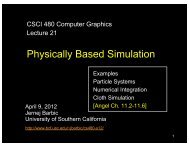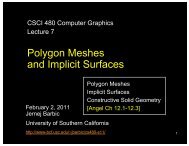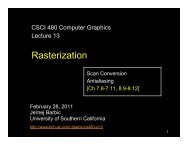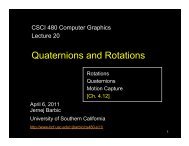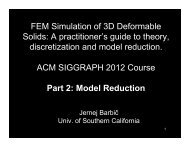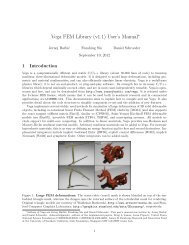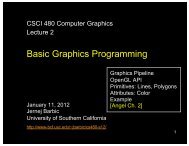CUDA: Introduction
CUDA: Introduction
CUDA: Introduction
Create successful ePaper yourself
Turn your PDF publications into a flip-book with our unique Google optimized e-Paper software.
<strong>CUDA</strong>: <strong>Introduction</strong><br />
Christian Trefftz / Greg Wolffe<br />
Grand Valley State University<br />
Supercomputing 2008<br />
Education Program<br />
(modifications by Jernej Barbic)<br />
Barbic
What is GPGPU?<br />
Terms<br />
General-Purpose computing on a Graphics<br />
Processing Unit<br />
Using graphic hardware for non-graphic<br />
computations<br />
What is <strong>CUDA</strong>?<br />
Compute Unified Device Architecture<br />
Software architecture for managing data-parallel<br />
programming<br />
2
Motivation<br />
3
CPU<br />
Fast caches<br />
Branching adaptability<br />
High performance<br />
GPU<br />
Multiple ALUs<br />
Fast onboard memory<br />
CPU vs. GPU<br />
High throughput on parallel tasks<br />
• Executes program on each fragment/vertex<br />
CPUs are great for task parallelism<br />
GPUs are great for data parallelism<br />
4
CPU vs. GPU - Hardware<br />
More transistors devoted to data processing<br />
5
Traditional Graphics Pipeline<br />
Vertex processing<br />
<br />
Rasterizer<br />
<br />
Fragment processing<br />
<br />
Renderer (textures)<br />
6
Pixel / Thread Processing<br />
7
GPU Architecture<br />
8
Processing Element<br />
Processing element = thread processor<br />
9
GPU Memory Architecture<br />
Uncached:<br />
Registers<br />
Shared Memory<br />
Local Memory<br />
Global Memory<br />
Cached:<br />
Constant Memory<br />
Texture Memory<br />
10
Data-parallel Programming<br />
Think of the GPU as a massively-threaded<br />
co-processor<br />
Write “kernel kernel” functions that execute on<br />
the device -- processing multiple data<br />
elements in parallel<br />
Keep it busy! massive threading<br />
Keep your data close! local memory<br />
11
Hardware Requirements<br />
<strong>CUDA</strong>-capable<br />
video card<br />
Power supply<br />
Cooling<br />
PCI-Express<br />
12
Acknowledgements<br />
NVidia Corporation<br />
developer.nvidia<br />
developer. nvidia.com/<strong>CUDA</strong><br />
.com/<strong>CUDA</strong><br />
NVidia<br />
Technical Brief – Architecture Overview<br />
<strong>CUDA</strong> Programming Guide<br />
ACM Queue<br />
http://www.acmqueue<br />
http://www. acmqueue.org/ .org/<br />
14
A Gentle <strong>Introduction</strong> to<br />
<strong>CUDA</strong> Programming<br />
15
Credits<br />
The code used in this presentation is based<br />
on code available in:<br />
the Tutorial on <strong>CUDA</strong> in Dr. Dobbs Journal<br />
Andrew Bellenir’s Bellenir code for matrix multiplication<br />
Igor Majdandzic’s Majdandzic code for Voronoi diagrams<br />
NVIDIA’s NVIDIA s <strong>CUDA</strong> programming guide<br />
16
Software Requirements/Tools<br />
<strong>CUDA</strong> device driver<br />
<strong>CUDA</strong> Toolkit (compiler, CUBLAS, CUFFT)<br />
<strong>CUDA</strong> Software Development Kit<br />
<strong>CUDA</strong> Software Development Kit<br />
Emulator<br />
Profiling:<br />
Occupancy calculator<br />
Visual profiler<br />
17
To compute, we need to:<br />
Allocate memory for the computation<br />
on the GPU (incl ( incl. . variables)<br />
Provide input data<br />
Specify the computation to be performed<br />
Read the results from the GPU (output)<br />
18
array<br />
Initially:<br />
CPU Memory GPU Card’s Memory<br />
19
Allocate Memory in the GPU<br />
array<br />
card<br />
array_d<br />
Host’s Memory GPU Card’s Memory<br />
20
Copy content from the host’s host s memory to the<br />
GPU card memory<br />
array<br />
array_d<br />
Host’s Memory GPU Card’s Memory<br />
21
Execute code on the GPU<br />
array<br />
GPU MPs<br />
array_d<br />
Host’s Memory GPU Card’s Memory<br />
22
Copy results back to the host<br />
array<br />
memory<br />
array_d<br />
Host’s Memory GPU Card’s Memory<br />
23
The code to be executed in the<br />
stream processors on the GPU<br />
Simultaneous execution in<br />
several (perhaps all) stream<br />
processors on the GPU<br />
How is every instance of the<br />
kernel going to know which<br />
piece of data it is working on?<br />
The Kernel<br />
24
Grid and Block Size<br />
Grid size: The number of blocks<br />
• Can be 1 or 2-dimensional array of blocks<br />
Each block is divided into threads<br />
• Can be 1, 2, or 3-dimensional array of threads<br />
25
Let’s Let s look at a very simple example<br />
The code has been divided into two files:<br />
simple.c<br />
simple.cu<br />
The code has been divided into two files:<br />
simple.c is ordinary code in C<br />
It allocates an array of integers, initializes<br />
it to values corresponding to the indices in<br />
the array and prints the array.<br />
It calls a function that modifies the array<br />
The array is printed again.<br />
26
#include .h><br />
#define SIZEOFARRAY 64<br />
extern void fillArray(int<br />
fillArray int *a,int *a, int size);<br />
simple.c<br />
/* The main program */<br />
int main(int main( int argc,char argc,char<br />
*argv * argv[]) [])<br />
{<br />
/* Declare the array that will be modified by the GPU */<br />
int a[SIZEOFARRAY];<br />
int i;<br />
/* Initialize the array to 0s */<br />
for(i=0 for( i=0;i ;i < SIZEOFARRAY;i++) {<br />
a[i]=0;<br />
}<br />
/* Print the initial array */<br />
printf("Initial printf("Initial<br />
state of the array:\n");<br />
for(i = 0;i < SIZEOFARRAY;i++) {<br />
printf("%d printf("%d<br />
",a[i]);<br />
}<br />
printf("\n"<br />
printf "\n"); );<br />
/* Call the function that will in turn call the function in the GPU that will fill<br />
the array */<br />
fillArray(a,SIZEOFARRAY);<br />
fillArray(a,SIZEOFARRAY);<br />
/* Now print the array after calling fillArray */<br />
printf("Final printf("Final<br />
state of the array:\n");<br />
for(i = 0;i < SIZEOFARRAY;i++) {<br />
printf("%d printf("%d<br />
",a[i]);<br />
}<br />
printf("\n"<br />
printf "\n"); );<br />
return 0;<br />
}<br />
27
simple.cu<br />
simple.cu contains two functions<br />
fillArray(): fillArray():<br />
A function that will be executed on<br />
the host and which takes care of:<br />
• Allocating variables in the global GPU memory<br />
• Copying the array from the host to the GPU memory<br />
• Setting the grid and block sizes<br />
• Invoking the kernel that is executed on the GPU<br />
• Copying the values back to the host memory<br />
• Freeing the GPU memory<br />
28
fillArray (part 1)<br />
#define BLOCK_SIZE 32<br />
extern "C" void fillArray(int<br />
fillArray int *array, int arraySize)<br />
arraySize<br />
{<br />
int * array_d; array_d<br />
cudaError_t result;<br />
/* cudaMalloc allocates space in GPU memory */<br />
result =<br />
cudaMalloc((void**)&<br />
cudaMalloc((void**)&array_d<br />
array_d,sizeof sizeof(int int)* )*arraySize<br />
arraySize); );<br />
/* copy the CPU array into the GPU array_d */<br />
result = cudaMemcpy(array_d<br />
cudaMemcpy array_d,array, ,array,sizeof sizeof(int int)* )*arraySize<br />
arraySize,<br />
cudaMemcpyHostToDevice);<br />
cudaMemcpyHostToDevice);<br />
29
}<br />
fillArray (part 2)<br />
/* Indicate block size */<br />
dim3 dimblock(BLOCK_SIZE);<br />
dimblock(BLOCK_SIZE);<br />
/* Indicate grid size */<br />
dim3 dimgrid(arraySize<br />
dimgrid arraySize / BLOCK_SIZE);<br />
/* Call the kernel */<br />
cu_fillArray>(array_d array_d); );<br />
/* Copy the results from GPU back to CPU memory */<br />
result =<br />
cudaMemcpy(array,<br />
cudaMemcpy(array,array_d<br />
array_d,sizeof sizeof(int int)* )*arraySize<br />
arraySize,cudaMemcpyDevice<br />
cudaMemcpyDevice<br />
ToHost); ToHost);<br />
/* Release the GPU memory */<br />
cudaFree(array_d<br />
cudaFree array_d); );<br />
30
simple.cu (cont.)<br />
The other function in simple.cu is cu_fillArray():<br />
cu_fillArray():<br />
This is the GPU kernel<br />
Identified by the keyword: __global__<br />
Built-in variables:<br />
• blockIdx.x blockIdx.x<br />
: block index within the grid<br />
• threadIdx.x: threadIdx.x:<br />
thread index within the block<br />
31
cu_fillArray<br />
__global__ void cu_fillArray(int<br />
cu_fillArray int * array_d) array_d<br />
{<br />
int x;<br />
x = blockIdx.x blockIdx.x<br />
* BLOCK_SIZE + threadIdx.x;<br />
threadIdx.x;<br />
array_d[x] array_d[x]<br />
= x;<br />
}<br />
__global__ void cu_addIntegers(int<br />
cu_addIntegers int * array_d1, int * array_d2)<br />
{<br />
int x;<br />
x = blockIdx.x blockIdx.x<br />
* BLOCK_SIZE + threadIdx.x;<br />
threadIdx.x;<br />
array_d1[x] += array_d2[x];<br />
}<br />
32
To compile:<br />
nvcc simple.c simple.cu –o o simple<br />
The compiler generates the code for both<br />
the host and the GPU<br />
Demo on cuda.littlefe.net …<br />
33
What are those blockIds and<br />
threadIds? threadIds<br />
With a minor modification to the code, we<br />
can print the blockIds and threadIds<br />
We will use two arrays instead of just one.<br />
One for the blockIds<br />
One for the threadIds<br />
The code in the kernel:<br />
x=blockIdx.x<br />
x= blockIdx.x*BLOCK_SIZE+threadIdx.x<br />
BLOCK_SIZE+threadIdx.x;<br />
block_d[x] block_d[x]<br />
= blockIdx.x;<br />
blockIdx.x<br />
thread_d[x] thread_d[x]<br />
= threadIdx.x;<br />
threadIdx.x<br />
34
Processing Elements<br />
Thread<br />
0<br />
Thread<br />
1<br />
Array Elements<br />
Thread<br />
2<br />
In the GPU:<br />
Thread<br />
3<br />
Thread<br />
0<br />
Thread<br />
1<br />
Block 0 Block 1<br />
Thread<br />
2<br />
Thread<br />
3<br />
35
Hands-on Activity<br />
Compile with (one single line)<br />
nvcc blockAndThread.c<br />
-o blockAndThread<br />
Run the program<br />
./blockAndThread<br />
./ blockAndThread<br />
blockAndThread.cu<br />
Edit the file blockAndThread.cu<br />
Modify the constant BLOCK_SIZE. The current value is<br />
8, try replacing it with 4.<br />
Recompile as above<br />
Run the program and compare the output with the<br />
previous run.<br />
36
This can be extended to 2 dimensions<br />
See files:<br />
blockAndThread2D.c<br />
blockAndThread2D.cu<br />
The gist in the kernel<br />
x = blockIdx.x*BLOCK_SIZE+threadIdx.x<br />
blockIdx.x BLOCK_SIZE+threadIdx.x;<br />
y = blockIdx.y*BLOCK_SIZE+threadIdx.y<br />
blockIdx.y BLOCK_SIZE+threadIdx.y;<br />
pos = x*sizeOfArray+y<br />
x* sizeOfArray+y;<br />
block_dX[pos] block_dX[pos]<br />
= blockIdx.x;<br />
blockIdx.x<br />
Compile and run blockAndThread2D<br />
nvcc blockAndThread2D.c blockAndThread2D.cu<br />
-o blockAndThread2D<br />
./blockAndThread2D<br />
37
When the kernel is called:<br />
dim3 dimblock(BLOCK_SIZE,BLOCK_SIZE);<br />
dimblock(BLOCK_SIZE,BLOCK_SIZE);<br />
nBlocks = arraySize/BLOCK_SIZE;<br />
arraySize/BLOCK_SIZE<br />
dim3 dimgrid(nBlocks<br />
dimgrid nBlocks,nBlocks nBlocks); );<br />
cu_fillArray><br />
(… params…);<br />
params );<br />
38
Another Example: saxpy<br />
SAXPY (Scalar Alpha X Plus Y)<br />
A common operation in linear algebra<br />
<strong>CUDA</strong>: loop iteration thread<br />
39
Traditional Sequential Code<br />
void saxpy_serial(int n,<br />
float alpha,<br />
float *x,<br />
float *y)<br />
{<br />
}<br />
for(int i = 0;i < n;i++) n;i++)<br />
y[i] y[i]<br />
= alpha*x[i<br />
alpha* x[i] ] + y[i]; y[i];<br />
40
<strong>CUDA</strong> Code<br />
__global__ void saxpy_parallel(int n,<br />
float alpha,<br />
float *x,<br />
float *y) {<br />
int i = blockIdx.x*blockDim.x+threadIdx.x<br />
blockIdx.x blockDim.x+threadIdx.x;<br />
if (i
“Warps Warps”<br />
Each block is split into SIMD groups of threads<br />
called "warps".<br />
Each warp contains the same number of threads,<br />
called the "warp size”<br />
size<br />
42
Block 1<br />
warp 1<br />
warp 2<br />
threads<br />
warp 3<br />
Block 2<br />
warp 1<br />
warp 2<br />
warp 3<br />
Block 3<br />
warp 1<br />
warp 2<br />
warp 3<br />
Multi-processor 1<br />
Block 3<br />
warp 1<br />
warp 2<br />
warp 3<br />
43
Keeping multiprocessors in mind… mind<br />
Each multiprocessor can process multiple blocks at a<br />
time.<br />
How many depends on the number of registers per<br />
thread and how much shared memory per block is<br />
required by a given kernel.<br />
If a block is too large, it will not fit into the resources of<br />
an MP.<br />
44
Performance Tip: Block Size<br />
Critical for performance<br />
Recommended value is 192 or 256<br />
Maximum value is 512<br />
Should be a multiple of 32 since this is the warp<br />
size for Series 8 GPUs and thus the native<br />
execution size for multiprocessors<br />
Limited by number of registers on the MP<br />
Series 8 GPU MPs have 8192 registers which<br />
are shared between all the threads on an MP<br />
45
Performance Tip: Grid Size<br />
Recommended value is at least 100, but 1000 would<br />
scale for many generations of hardware<br />
Actual value depends on problem size<br />
It should be a multiple of the number of MPs for an even<br />
distribution of work (not a requirement though)<br />
Example: 24 blocks<br />
Grid will work efficiently on Series 8 (12 MPs), but it will waste<br />
resources on new GPUs with 32MPs<br />
46
Memory Alignment<br />
Memory access faster if data aligned at 64<br />
byte boundaries<br />
Hence, allocate 2D arrays so that every<br />
row starts at a 64-byte boundary<br />
Tedious for a programmer<br />
47
Allocating 2D arrays with “pitch pitch”<br />
<strong>CUDA</strong> offers special versions of:<br />
Memory allocation of 2D arrays so that every row<br />
is padded (if necessary): cudaMallocPitch()<br />
cudaMallocPitch()<br />
Memory copy operations that take into account the<br />
pitch: cudaMemcpy2D()<br />
48
Rows<br />
Pitch<br />
Columns<br />
Pitch<br />
Padding<br />
49
A simple example:<br />
See pitch.cu<br />
A matrix of 30 rows and 10 columns<br />
The work is divided into 3 blocks of 10<br />
rows:<br />
Block size is 10<br />
Grid size is 3<br />
50
Key portions of the code (1)<br />
result = cudaMallocPitch(<br />
cudaMallocPitch<br />
(void **)&devPtr<br />
**)&devPtr,<br />
&pitch,<br />
width*sizeof<br />
width* sizeof(int int), ),<br />
height);<br />
51
Key portions of the code (2)<br />
result = cudaMemcpy2D(<br />
devPtr, devPtr<br />
pitch,<br />
mat,<br />
width*sizeof<br />
width* sizeof(int int), ),<br />
width*sizeof<br />
width* sizeof(int int), ),<br />
height,<br />
cudaMemcpyHostToDevice);<br />
cudaMemcpyHostToDevice);<br />
52
In the kernel:<br />
__global__ void myKernel(int<br />
myKernel int *devPtr devPtr,<br />
int pitch,<br />
int width,<br />
int height)<br />
{<br />
}<br />
\<br />
int c;<br />
int thisRow; thisRow<br />
thisRow = blockIdx.x blockIdx.x<br />
* 10 + threadIdx.x;<br />
threadIdx.x;<br />
int *row = (int ( int *)((char *)devPtr *) devPtr +<br />
thisRow*pitch);<br />
thisRow*pitch);<br />
for(c = 0;c < width;c++)<br />
row[c] = row[c] + 1;<br />
53
The call to the kernel<br />
myKernel(<br />
myKernel(<br />
devPtr, devPtr<br />
pitch,<br />
width,<br />
height);<br />
54
pitch Divide work by rows<br />
Notice that when using pitch, we divide the<br />
work by rows.<br />
Instead of using the 2D decomposition of<br />
2D blocks, we are dividing the 2D matrix<br />
into blocks of rows.<br />
55
Dividing the work by blocks:<br />
Rows<br />
Columns<br />
Pitch<br />
Block 0<br />
Block 1<br />
Block 2<br />
56
An application that uses pitch:<br />
The Mandelbrot set: A set of<br />
points in the complex plane,<br />
the boundary of which forms a<br />
fractal.<br />
A complex number, c, , is in the<br />
Mandelbrot set if, when<br />
starting with x0=0 =0 and applying<br />
the iteration<br />
xn+1 +1 = x 2<br />
n + c<br />
repeatedly, the absolute value<br />
of xn never exceeds a certain<br />
number (that number depends<br />
on c) ) however large n gets.<br />
Mandelbrot<br />
57
Performance Tip: Code Divergence<br />
Control flow instructions diverge (threads take<br />
different paths of execution)<br />
Example: if, for, while<br />
Diverged code prevents SIMD execution – it<br />
forces serial execution (kills efficiency)<br />
One approach is to invoke a simpler kernel<br />
multiple times<br />
Liberal use of __syncthreads()<br />
__syncthreads()<br />
58
Performance Tip: Memory Latency<br />
4 clock cycles for each memory read/write plus<br />
additional 400-600 cycles for latency<br />
Memory latency can be hidden by keeping a large<br />
number of threads busy<br />
Keep number of threads per block (block size) and<br />
number of blocks per grid (grid size) as large as possible<br />
Constant memory can be used for constant data<br />
(variables that do not change).<br />
Constant memory is cached.<br />
59
Performance Tip: Memory Reads<br />
Device is capable of reading a 32, 64 or 128-bit<br />
number from memory with a single instruction<br />
Data has to be aligned in memory (this can be<br />
accomplished by using cudaMallocPitch() cudaMallocPitch()<br />
calls)<br />
If formatted properly, multiple threads from a<br />
warp can each receive a piece of memory with a<br />
single read instruction<br />
60
Watchdog timer<br />
OS may force programs using the GPU to time out if<br />
running too long<br />
Exceeding the limit can cause <strong>CUDA</strong> program<br />
failure.<br />
Possible solution: run <strong>CUDA</strong> on a GPU that is NOT<br />
attached to a display.<br />
61
Resources on line<br />
http://www.acmqueue.org/modules.php?name<br />
http:// www.acmqueue.org/modules.php?name=<br />
Content&pa=showpage&pid<br />
Content&pa showpage&pid=532 =532<br />
http://www.ddj.com/hpc-high-performance<br />
computing/207200659<br />
http://www.nvidia.com/object/cuda_home.html<br />
http:// www.nvidia.com/object/cuda_home.html#<br />
http://www.nvidia.com/object/cuda_learn.html<br />
http:// www.nvidia.com/object/cuda_learn.html<br />
“Computation Computation of Voronoi diagrams using a<br />
graphics processing unit” unit by Igor Majdandzic et<br />
al. available through IEEE Digital Library, DOI:<br />
10.1109/EIT.2008.4554342<br />
62
A Real Application<br />
The Voronoi Diagram:<br />
A fundamental data<br />
structure in<br />
Computational<br />
Geometry<br />
63
Definition<br />
Definition : Let S be a set of n sites in<br />
Euclidean space of dimension d. For each<br />
site p of S, the Voronoi cell V(p) V(p)<br />
of p is the<br />
set of points that are closer to p than to<br />
other sites of S. The Voronoi diagram V(S)<br />
is the space partition induced by Voronoi<br />
cells.<br />
64
Algorithms<br />
The classical sequential algorithm has<br />
complexity O(n log n) where n is the number<br />
of sites (seeds).<br />
If one only needs an approximation, on a grid<br />
of points (e.g. digital display):<br />
Assign a different color to each seed<br />
Calculate the distance from every point in the grid<br />
to all seeds<br />
Color each point with the color of its closest seed<br />
65
Lends itself to implementation on a<br />
GPU… GPU<br />
The calculation for every pixel is a good<br />
candidate to be carried out in parallel… parallel<br />
Notice that the locations of the seeds are<br />
read-only in the kernel<br />
Thus we can use the texture map area in<br />
the GPU card, which is a fast read-only<br />
cache to store the seeds:<br />
__device__ __constant__ …<br />
66



